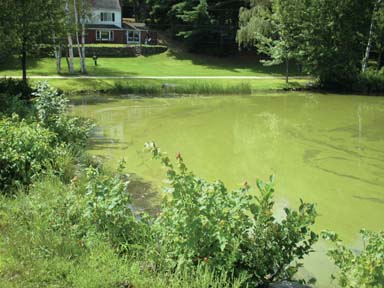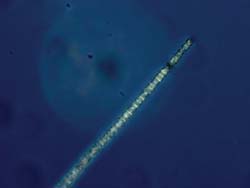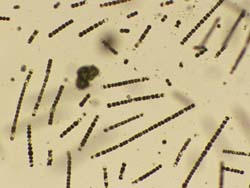 |
 |
| current issue |  | past issues |  | send a letter/news |  | address update |  | advertise |  | about us |  | alumni home |
Features
Dangerous WatersPage 2 of 2
Paul Cox, a world-renowned ethnobotanist, visited UNH recently to tell about his efforts to solve one of the great medical mysteries. Why has the native population of Chamorros on Guam had an incidence of a fatal ALS-like disease up to 100 times higher than normal? At its peak in the 1950s, 25 to 30 percent of the population succumbed to the ailment, in the largest cluster of the disease ever documented. The culprit, Cox concluded, was the Chamorros' predilection for a local delicacy, the giant fruit bat—which they devoured fur, head, and all.
When analysis of the preserved brains of victims of the disease revealed high levels of BMAA, Cox saw a classic case of biomagnification. In a "House That Jack Built" sort of chain of causality, the Chamorro are the people who ate the bats, who ate the cycad seeds, which contain the BMAA, which is produced by the blue-green algae, which live symbiotically in cycad roots.
The surprising discovery of BMAA in the brains of some of Cox's controls—who were victims of Alzheimer's disease—strengthened his hypothesis that blue-green algae toxins may cause neurodegenerative disease in susceptible people.
When Cox published his findings in Neurology in 2002, some neurologists welcomed his scientific crossover, but others were skeptical, particularly scientists who had promoted other theories about the Chamorro mystery. Some of his results have been confirmed independently, however, and scientists at the University of Miami have just published a study in which high levels of BMAA were detected in 49 out of 50 brain samples from North American ALS and Alzheimer's victims.

|
| BOW LAKE: Blue-green algae can look chartreuse, pea green, brown, white or purple. |
If BMAA does somehow cause neurodegenerative diseases—by damaging glutamate receptors in the brain, perhaps, or replacing normal amino acids in brain proteins—scientists believe the process would only occur in people who have a genetic predisposition to accumulate the toxin.
Haney and Stommel plan to explore the possible correlation between ALS and algae through patient interviews, tests of water and fish, and sophisticated mapping and statistical analysis. Cox's lab will assist with analysis of hair and brain samples from victims. Lake-bottom cores can give clues to past levels of contamination. Haney found, for example, that a sudden jump in toxin levels revealed the point when a state fish hatchery came online 70 years ago and started polluting a Berlin, N.H., lake with nutrients. In the seemingly upside-down world of lake management, "nutrients" and "feeding" are not nice words.
On a Thursday night in May, several pairs of UNH students presented the results of a semester-long study of the water quality in local lakes before a small audience. It was the culmination of Haney's lake management course, which provides a service to the state while training students from a variety of majors.
Although each lake was different, the recommendation for maintaining or improving water quality was invariably the same: reduce or prevent the flow of nutrients into the lake. Nutrients such as phosphate from fertilizers, animal wastes and detergents can lead to overgrowth of aquatic organisms. The solution is to maintain a buffer of vegetation along the shore, reduce or eliminate use of fertilizer adjacent to the lake, keep septic systems well maintained and resist the pressure to pave over swaths of land in the lake's watershed.
An important goal of the algae and ALS project is to raise public awareness. The N.H. Department of Environmental Services and UNH Cooperative Extension will play key roles in this part of the project. New Hampshire already has 900 citizen volunteers monitoring the water quality of lakes across the state under the guidance of UNH and Cooperative Extension, and 500 more, under N.H. Department of Environmental Services' supervision, are watching for invasive weeds. Members of both monitoring programs have already started to learn about signs of algae problems in lakes. Other efforts will be aimed at informing veterinarians and medical doctors so that they can be on the lookout for algae-related illness.
In the meantime, the experts recommend several ways to avoid getting sick from algae toxins. The most obvious caveat is to avoid drinking contaminated water, which can happen inadvertently while swimming during a bloom. Haney cautions that the toxins in blue-green algae are not destroyed, and may even be intensified, by boiling. They can also concentrate in shellfish or finfish in contaminated lakes, bays, rivers or oceans. "Aerosolization," a documented means of transmission of toxins such as red tide, could theoretically spread contaminants through wind, or the spray created by waterskiing. And perhaps it goes without saying that you won't find blue-green algae supplements on the kitchen shelves of any of these researchers.
The scientists want to convey concern, but not alarm, about the algae in New Hampshire lakes. In general, the lakes have tested below the WHO drinking-level standards, except during active blooms. "I'd be thrilled to own a cottage on a New Hampshire lake," says Cox, whose Institute for Ethnomedicine is based in Wyoming. In fact, northern New England has less of a problem with blue-green algae blooms than many states with more development, more farming or a warmer climate.

|

|

|
| TOXIC: Blue-green algae gave us the oxygen that we breathe by "inventing" photosynthesis, but some species produce toxins that are harmful to humans and can kill a dog in minutes. | ||
David Hersey has his own, rather metaphysical, theory as to why he may have contracted ALS. In the year 2000, virtually everyone he had ever been close to died, one after another, of unrelated diseases, mostly cancer. Can it be a coincidence, he muses, that someone could suffer such a devastating series of losses, and then contract a disease where "everything is gradually disappearing"?
Hersey isn't part of an ALS cluster, although he did spend many a summer afternoon swimming in a local lake as a boy and also lived for more than 20 years near (and often rollerbladed along) the Charles River in Boston, which has also had algae blooms. "I do feel like the neurotoxic effect of these algae blooms is a piece of the puzzle," he says.
Even if they don't receive the National Institute of Environmental Health grant, says Haney, the researchers will find the money to continue working on this puzzle. "We think we live in this Garden of Eden world and assume everything out there is there for us to use, that lakes are free of problems," he warns. "But there are problems out there that we don't know about."
And whether the result of algae toxins is just an upset stomach or one of mankind's most dread diseases, this is one of those times when what we don't know can hurt us. ~
Page: < Previous 1 2
Easy to print version
blog comments powered by Disqus
